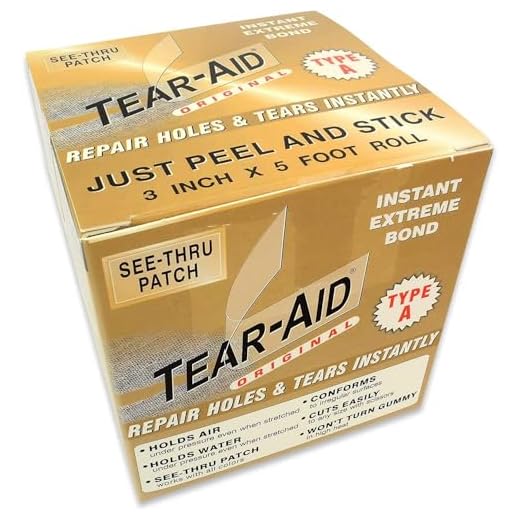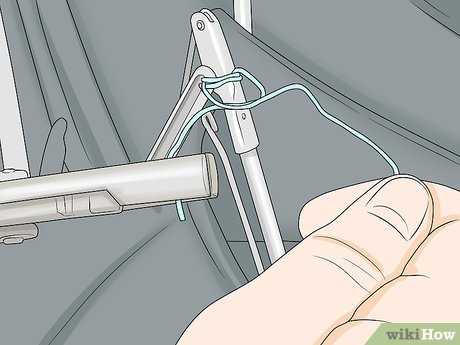


Using adhesive fabric patches is the most reliable method to restore your canopy’s integrity. This article provides detailed steps and materials needed for a successful repair, ensuring you can continue using your protective covering without leaks.
This guide is geared towards individuals who want to extend the life of their weather-shielding accessory, whether for personal use or professional settings. It offers practical solutions that can be completed in a short time, saving you from the cost of replacement.
In the following sections, I will outline the necessary materials, step-by-step instructions for applying patches, and tips for maintaining your covering after repairs. By following these guidelines, you can effectively manage minor damages and keep your gear in optimal condition.
Best Way to Repair a Rip on a Canopy
Use a strong adhesive patch for a quick and reliable solution. Cut a piece of fabric or a repair patch slightly larger than the damaged area. Clean the surface around the rip to ensure a good bond.
After preparing the patch, apply a waterproof adhesive to both the patch and the damaged fabric. Press the patch firmly over the rip, ensuring there are no air bubbles trapped underneath. Allow it to cure according to the adhesive’s instructions.
Additional Tips
For a more durable fix, consider sewing the edges of the patch in addition to using adhesive. This method reinforces the bond and can extend the life of the repair.
- Choose a fabric patch that matches the original material for aesthetics.
- Use a needle and thread that can withstand moisture.
- If the damage is extensive, consider reinforcing the entire section with a larger patch.
Regularly inspect your canopy for any signs of wear and address them promptly to prolong its lifespan.
Assessing the Damage: Identifying the Tear Type
Begin by examining the fabric for the nature of the damage. Distinguishing between the types of rips will inform the repair method. There are generally two categories: clean cuts and frayed edges. Clean cuts are straight and well-defined, while frayed edges may have multiple threads loose, indicating a more complex issue.
Consider the size of the damage as well. Small holes can often be treated with simple adhesive patches, while larger openings may require sewing or more robust solutions. The location of the damage is also crucial; tears near the edges can often be mended more easily than those in the center of a panel.
Types of Damage
- Clean Cuts: These are straight and can indicate a sharp object has caused the issue.
- Frayed Edges: Multiple loose threads suggest wear and may require more careful handling.
- Holes: Small punctures can often be fixed quickly, while larger ones may need more substantial intervention.
After identifying the type, gather your materials based on the findings. For clean cuts, a strong adhesive or patch material is suitable. For frayed edges, consider using thread and needle for a more durable fix. Assessing the damage accurately ensures that the chosen method will restore functionality effectively.
Choosing the Right Materials for Effective Repair
For a successful mending process, selecting appropriate materials is critical. Fabrics such as nylon or polyester are commonly used due to their water-resistant properties and durability. These materials can withstand exposure to the elements, ensuring the longevity of any repair.
Adhesives play a significant role in the repair process. Opt for waterproof fabric glue to create a strong bond that resists moisture. Additionally, double-sided tape can be useful for quick fixes, while iron-on patches offer a more permanent solution. It’s essential to consider the weight and thickness of the materials to ensure they adhere well and do not compromise the structure.
Additional Material Suggestions
- Fabric Patches: Look for patches made from similar materials as the original canopy for better integration.
- Seam Sealant: This can be applied to edges to prevent further fraying.
- Waterproofing Spray: After repairs, applying a waterproofing agent can enhance resistance against moisture.
Ultimately, the combination of durable fabrics and reliable adhesives contributes significantly to the repair’s success. By carefully selecting these materials, you can ensure a reliable and lasting solution to any damage.
Step-by-Step Guide: Patching Techniques Explained
To address damage on your canopy, begin by gathering necessary materials: fabric patch, adhesive, scissors, and a clean cloth. Ensure the area around the damage is dry and clean for optimal adhesion.
First, cut a fabric patch slightly larger than the damage. This will allow for proper coverage and prevent further fraying. Next, apply a thin layer of adhesive to both the patch and the damaged area. Press the patch firmly onto the surface and smooth out any air bubbles.
Follow-Up Care
After applying the patch, allow it to cure as per the adhesive instructions. For added protection, you might consider sealing the edges with additional adhesive or fabric sealant to prevent moisture from seeping in.
Lastly, check the repair periodically to ensure integrity. If the damage reopens or worsens, repeat the process as necessary. Keeping your shelter in good shape prolongs its lifespan and enhances its functionality.
Preventive Measures to Extend Umbrella Lifespan
Regular maintenance is key to ensuring your canopy stays in excellent condition for as long as possible. After each use, shake off any excess moisture and allow it to dry fully before storing. This simple practice helps prevent mold and deterioration of the fabric.
Store your canopy in a cool, dry place away from direct sunlight. Prolonged exposure to UV rays can weaken the material and cause fading. Additionally, consider using a protective cover to shield it from dust and debris during periods of non-use.
Additional Tips for Care
- Inspect your canopy regularly for any signs of wear or damage.
- Keep the frame clean by wiping it down with a damp cloth to remove dirt and grime.
- Avoid using force when opening or closing to prevent bending or breaking the ribs.
- During windy conditions, it’s wise to close the canopy to avoid stress on the frame.
By implementing these care strategies, you can significantly enhance the longevity of your protective accessory, ensuring it serves you well through many seasons.
Best way to patch a tear on a rain umbrella
Features
| Part Number | Clear |
| Model | Clear |
| Color | Clear |
| Size | 6 - Pack |
Features
| Part Number | MOON0910 |
| Color | 10 Patches |
| Size | 4inch or less |
Features
| Part Number | TA-D-ROLL-A-2 |
| Model | TA-D-ROLL-A-2 |
| Color | Clear |
| Size | 3 x 5.5 inches |
| Language | English |
Video:
FAQ:
How can I properly prepare a tear on my umbrella before applying a patch?
Before applying a patch to a tear on your umbrella, you should first clean the area around the tear to remove dirt and moisture. Use a damp cloth to wipe the fabric, and allow it to dry completely. Next, trim any frayed edges around the tear to create a smooth surface for the patch. This preparation step is crucial as it helps the adhesive or patch material bond better with the umbrella fabric, leading to a more reliable repair.
Are there any tips for maintaining the repair on my umbrella after patching the tear?
After patching a tear on your umbrella, it’s important to take some steps to maintain the repair. First, avoid exposing the repaired area to excessive force or stress, as this may cause the patch to peel or come loose. Store the umbrella in a dry place when not in use to prevent moisture buildup, which can weaken the adhesive over time. Additionally, periodically check the patch to ensure it remains intact and reapply adhesive if necessary. Taking these precautions can extend the life of your umbrella and the effectiveness of the repair.
What are the best materials to use for patching a tear on a rain umbrella?
When patching a tear on a rain umbrella, the best materials to use include waterproof fabric patches, adhesive fabric tape, or even clear waterproof adhesive. Waterproof fabric patches can be cut to size and applied over the tear, creating a strong seal against moisture. Adhesive fabric tape is also effective, as it can be easily applied and is designed to withstand wet conditions. For smaller tears, a clear waterproof adhesive can be used to bond the fabric edges together permanently. Make sure to clean the area around the tear thoroughly before applying any patch to ensure a secure hold.







